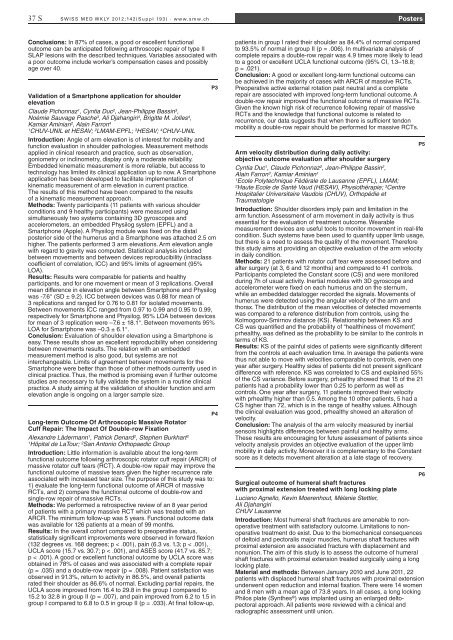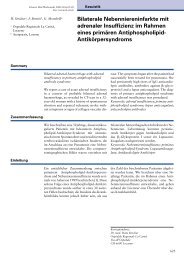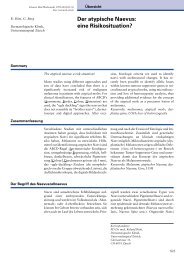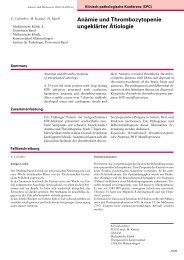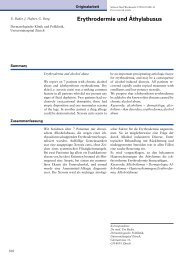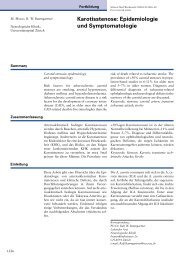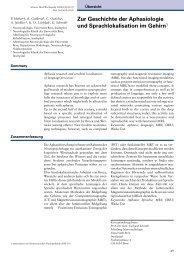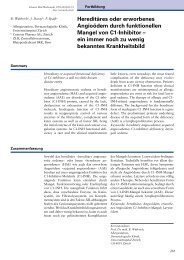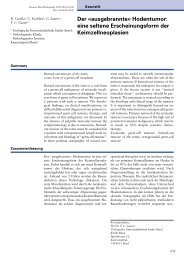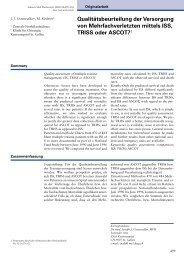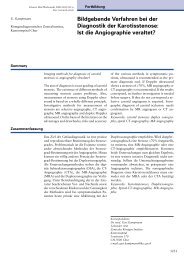SMW Supplementum 193 - Swiss Medical Weekly
SMW Supplementum 193 - Swiss Medical Weekly
SMW Supplementum 193 - Swiss Medical Weekly
Create successful ePaper yourself
Turn your PDF publications into a flip-book with our unique Google optimized e-Paper software.
37 S SWiSS Med Wkly 2012;142(Suppl <strong>193</strong>) · www.smw.ch Posters<br />
Conclusions: In 87% of cases, a good or excellent functional<br />
outcome can be anticipated following arthroscopic repair of type II<br />
SLAP lesions with the described techniques. Variables associated with<br />
a poor outcome include worker’s compensation cases and possibly<br />
age over 40.<br />
P3<br />
Validation of a Smartphone application for shoulder<br />
elevation<br />
Claude Pichonnaz1 , Cyntia Duc2 , Jean-Philippe Bassin3 ,<br />
Noémie Sauvage Pasche3 , Ali Djahangiri4 , Brigitte M. Jolles4 ,<br />
Kamiar Aminian2 , Alain Farron4 1 2 3 4 CHUV-UNIL et HESAV; LMAM-EPFL; HESAV; CHUV-UNIL<br />
Introduction: Angle of arm elevation is of interest for mobility and<br />
function evaluation in shoulder pathologies. Measurement methods<br />
applied in clinical research and practice, such as observation,<br />
goniometry or inclinometry, display only a moderate reliability.<br />
Embedded kinematic measurement is more reliable, but access to<br />
technology has limited its clinical application up to now. A Smartphone<br />
application has been developed to facilitate implementation of<br />
kinematic measurement of arm elevation in current practice.<br />
The results of this method have been compared to the results<br />
of a kinematic measurement approach.<br />
Methods: Twenty participants (11 patients with various shoulder<br />
conditions and 9 healthy participants) were measured using<br />
simultaneously two systems containing 3D gyroscopes and<br />
accelerometers, an embedded Physilog system (EPFL) and a<br />
Smartphone (Apple). A Physilog module was fixed on the distal<br />
posterior side of the humerus and a Smartphone was attached 2.5 cm<br />
higher. The patients performed 3 arm elevations. Arm elevation angle<br />
with regard to gravity was computed. Statistical analysis included<br />
between movements and between devices reproducibility (intraclass<br />
coefficient of correlation, ICC) and 95% limits of agreement (95%<br />
LOA).<br />
Results: Results were comparable for patients and healthy<br />
participants, and for one movement or mean of 3 replications. Overall<br />
mean difference in elevation angle between Smartphone and Physilog<br />
was -7.6° (SD ± 9.2). ICC between devices was 0.88 for mean of<br />
3 replications and ranged for 0.76 to 0.81 for isolated movements.<br />
Between movements ICC ranged from 0.97 to 0.99 and 0.95 to 0.99,<br />
respectively for Smartphone and Physilog. 95% LOA between devices<br />
for mean of 3 replication were –7.6 ± 18.1°. Between movements 95%<br />
LOA for Smartphone was –0.3 ± 6.1°.<br />
Conclusion: Evaluation of shoulder elevation using a Smartphone is<br />
easy. These results show an excellent reproducibility when considering<br />
between movements results. The relation with an embedded<br />
measurement method is also good, but systems are not<br />
interchangeable. Limits of agreement between movements for the<br />
Smartphone were better than those of other methods currently used in<br />
clinical practice. Thus, the method is promising even if further outcome<br />
studies are necessary to fully validate the system in a routine clinical<br />
practice. A study aiming at the validation of shoulder function and arm<br />
elevation angle is ongoing on a larger sample size.<br />
P4<br />
Long-term Outcome Of Arthroscopic Massive Rotator<br />
Cuff Repair: The Impact Of Double-row Fixation<br />
Alexandre Lädermann1 , Patrick Denard2 , Stephen Burkhart2 1Hôpital de LaTour; 2San Antonio Orthopaedic Group<br />
Introduction: Little information is available about the long-term<br />
functional outcome following arthroscopic rotator cuff repair (ARCR) of<br />
massive rotator cuff tears (RCT). A double-row repair may improve the<br />
functional outcome of massive tears given the higher recurrence rate<br />
associated with increased tear size. The purpose of this study was to:<br />
1) evaluate the long-term functional outcome of ARCR of massive<br />
RCTs, and 2) compare the functional outcome of double-row and<br />
single-row repair of massive RCTs.<br />
Methods: We performed a retrospective review of an 8 year period<br />
of patients with a primary massive RCT which was treated with an<br />
ARCR. The minimum follow-up was 5 years. Functional outcome data<br />
was available for 126 patients at a mean of 99 months.<br />
Results: In the overall cohort compared to preoperative status,<br />
statistically significant improvements were observed in forward flexion<br />
(132 degrees vs. 168 degrees; p < .001), pain (6.3 vs. 1.3; p < .001),<br />
UCLA score (15.7 vs. 30.7; p < .001), and ASES score (41.7 vs. 85.7;<br />
p < .001). A good or excellent functional outcome by UCLA score was<br />
obtained in 78% of cases and was associated with a complete repair<br />
(p = .035) and a double-row repair (p = .008). Patient satisfaction was<br />
observed in 91.3%, return to activity in 86.5%, and overall patients<br />
rated their shoulder as 86.6% of normal. Excluding partial repairs, the<br />
UCLA score improved from 16.4 to 29.8 in the group I compared to<br />
15.2 to 32.8 in group II (p = .007), and pain improved from 6.2 to 1.5 in<br />
group I compared to 6.8 to 0.5 in group II (p = .033). At final follow-up,<br />
patients in group I rated their shoulder as 84.4% of normal compared<br />
to 93.5% of normal in group II (p = .006). In multivariate analysis of<br />
complete repairs a double-row repair was 4.9 times more likely to lead<br />
to a good or excellent UCLA functional outcome (95% CI, 1.3–18.8;<br />
p = .021).<br />
Conclusion: A good or excellent long-term functional outcome can<br />
be achieved in the majority of cases with ARCR of massive RCTs.<br />
Preoperative active external rotation past neutral and a complete<br />
repair are associated with improved long-term functional outcome. A<br />
double-row repair improved the functional outcome of massive RCTs.<br />
Given the known high risk of recurrence following repair of massive<br />
RCTs and the knowledge that functional outcome is related to<br />
recurrence, our data suggests that when there is sufficient tendon<br />
mobility a double-row repair should be performed for massive RCTs.<br />
P5<br />
Arm velocity distribution during daily activity:<br />
objective outcome evaluation after shoulder surgery<br />
Cyntia Duc1 , Claude Pichonnaz2 , Jean-Philippe Bassin2 ,<br />
Alain Farron3 , Kamiar Aminian1 1Ecole Polytechnique Fédérale de Lausanne (EPFL), LMAM;<br />
2 3 Haute Ecole de Santé Vaud (HESAV), Physiothérapie; Centre<br />
Hospitalier Universitaire Vaudois (CHUV), Orthopédie et<br />
Traumatologie<br />
Introduction: Shoulder disorders imply pain and limitation in the<br />
arm function. Assessment of arm movement in daily activity is thus<br />
essential for the evaluation of treatment outcome. Wearable<br />
measurement devices are useful tools to monitor movement in real-life<br />
condition. Such systems have been used to quantify upper limb usage,<br />
but there is a need to assess the quality of the movement. Therefore<br />
this study aims at providing an objective evaluation of the arm velocity<br />
in daily condition.<br />
Methods: 21 patients with rotator cuff tear were assessed before and<br />
after surgery (at 3, 6 and 12 months) and compared to 41 controls.<br />
Participants completed the Constant score (CS) and were monitored<br />
during 7h of usual activity. Inertial modules with 3D gyroscope and<br />
accelerometer were fixed on each humerus and on the sternum,<br />
while an embedded datalogger recorded the signals. Movements of<br />
humerus were detected using the angular velocity of the arm and<br />
thorax. The distribution of the mean velocities of detected movements<br />
was compared to a reference distribution from controls, using the<br />
Kolmogorov-Smirnov distance (KS). Relationship between KS and<br />
CS was quantified and the probability of “healthiness of movement”,<br />
prhealthy, was defined as the probability to be similar to the controls in<br />
terms of KS.<br />
Results: KS of the painful sides of patients were significantly different<br />
from the controls at each evaluation time. In average the patients were<br />
thus not able to move with velocities comparable to controls, even one<br />
year after surgery. Healthy sides of patients did not present significant<br />
difference with reference. KS was correlated to CS and explained 55%<br />
of the CS variance. Before surgery, prhealthy showed that 15 of the 21<br />
patients had a probability lower than 0.25 to perform as well as<br />
controls. One year after surgery, 11 patients improved their velocity<br />
with prhealthy higher than 0.5. Among the 10 other patients, 5 had a<br />
CS higher than 72, which is in the range of healthy values. Although<br />
the clinical evaluation was good, prhealthy showed an alteration of<br />
velocity.<br />
Conclusion: The analysis of the arm velocity measured by inertial<br />
sensors highlights differences between painful and healthy arms.<br />
These results are encouraging for future assessment of patients since<br />
velocity analysis provides an objective evaluation of the upper limb<br />
mobility in daily activity. Moreover it is complementary to the Constant<br />
score as it detects movement alteration at a late stage of recovery.<br />
P6<br />
Surgical outcome of humeral shaft fractures<br />
with proximal extension treated with long locking plate<br />
Luciano Agnello, Kevin Moerenhout, Mélanie Stettler,<br />
Ali Djahangiri<br />
CHUV Lausanne<br />
Introduction: Most humeral shaft fractures are amenable to nonoperative<br />
treatment with satisfactory outcome. Limitations to nonoperative<br />
treatment do exist. Due to the biomechanical consequences<br />
of deltoid and pectoralis major muscles, humerus shaft fractures with<br />
proximal extension are associated fracture with displacement and<br />
nonunion. The aim of this study is to assess the outcome of humeral<br />
shaft fractures with proximal extension treated surgically using a long<br />
locking plate.<br />
Material and methods: Between January 2010 and June 2011, 22<br />
patients with displaced humeral shaft fractures with proximal extension<br />
underwent open reduction and internal fixation. There were 14 women<br />
and 8 men with a mean age of 73.8 years. In all cases, a long locking<br />
Philos plate (Synthes ® ) was implanted using an enlarged deltopectoral<br />
approach. All patients were reviewed with a clinical and<br />
radiographic assessment until union.


